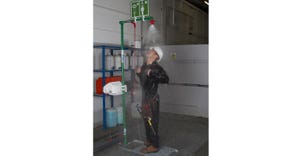Challenges Implementing a Loss-in-Weight Feeder Solution
August 30, 2012
Since the advent of the loss-in-weight (LIW) feeder, many advances have been achieved in their performance, controls, and mechanical design. LIW feeders serve as a viable alternative to other bulk material control devices such as weigh belt feeders.
However, even with proven technology, users of LIW feeders can experience poor performance or results. Due to the demanding applications that require a LIW feeder, correctly specifying, installing, operating, and maintaining a LIW feeder is essential, yet can prove challenging.
A LIW feeder controls the rate at which material is fed into a process. This enables the user to blend materials together to create consistent mixtures. This ability to provide “repeatable” blends and products is desirable for many reasons, including: bulk material cost savings; better product quality; ability to reproduce a product independent of the production environment; ability to store real time data for record keeping or process improvement.
A LIW feeder typically consists of a material supply hopper, a weighing device, and a material metering device. Material from the supply hopper is fed into the downstream process by a metering device such as a screw or vibratory tray. As the material leaves the supply hopper, the amount of material weight that is lost is used to calculate a feed rate. The feed rate is compared to the user’s desired feed rate (set point) and a micro-processor controller increases or decreases the throughput to control the feed rate based on the “loss in weight” of the material.
The formula for calculating feed rate is simple: the amount of material weight lost divided by the time period over which it was lost. While this is a very basic calculation, there are many factors which require additional and more complex algorithms which are often misunderstood or poorly configured.
When only a LIW feeder will work for an application, proper preparation will increase the likelihood of trouble free operation. There are many factors that can negatively affect the performance of a LIW feeder. These factors include: the capacity of the weighing device; hopper size in relation to the amount of weight lost; the mounting structure and surrounding equipment where the feeder will be installed; air flow within and external to the LIW feeder; the material refill system; flow characteristics of the material.
A user will normally rely on the expertise of an experienced feeder manufacturer for proper design, and application of a LIW feeder. However, if the manufacturer does not have key or correct information, it can cause poor performance or failure of the LIW feeder when installed. Critical application information includes: accurate description of the material, including particle size and bulk density; minimum and maximum feed rates; a detailed description of the physical area where the feeder will be installed.
Feeder manufacturers normally have the ability to test a material in a LIW feeder. While this can reduce the chance of misapplication, the physical installation itself remains important. It is important to ensure that the LIW feeder is well isolated from external vibration and air influences which are often not duplicated in a test lab. Connections to the feeder must be supple to avoid transferring vibration and physical influences to the weighing system. Something as simple as a fan blowing intermittently on a LIW feeder or a leaking refill gate can cause poor performance and lack of control. To someone inexperienced with LIW feeders, these types of problems can also be hard to identify. While the process controller can be programmed to filter some external influences, it is much better to start with a stable physical installation.
If the correct device for an application is a LIW feeder, make sure that accurate and complete information is supplied to the manufacturer early in the implementation process. Pay close attention to the physical installation as this is the area that creates the most performance issues with LIW feeders. Finally, be prepared to face a different set of challenges in maintaining and troubleshooting a loss-in-weight feeder. If a LIW feeder has been correctly designed, applied, and installed correctly, it should perform as well as any other type of gravimetric feeder.
Steve Musser is vice president of process industries at Merrick Industries Inc., Lynn Haven, FL. He has been employed at Merrick in engineering and management for 23 years.
You May Also Like


